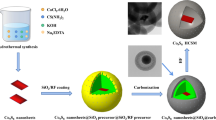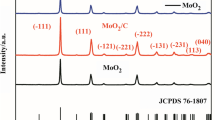Abstract
Uniformly dispersed ultra-small hollow Co9S8 nanoparticles (<10 nm) (H-Co9S8@C) and solid Co9S8 nanoparticles (S-Co9S8@C) in porous carbon were fabricated separately by solvothermal and sulfur powder sulphurisation using Co-MOF-74 as the template. Owing to significant structural stability and uniform hollow structure of carbon-encapsulated Co9S8, the as-prepared H-Co9S8@C exhibited excellent lithium ion storage performance as an anode material. Worked in the voltage of 0.01–3.0 V, H-Co9S8@C revealed outstanding rate capability (850, 670, 613, 552, 457, and 347 mA h/g at 0.1, 0.2, 0.5, 1, 2, and 3 A/g, respectively), and high reversible capacity (after 250 cycles with a remained capacity of 900.5 mA h/g). Compared with S-Co9S8@C, over 50 cycles, the discharge specific capacity of H-Co9S8@C was still maintained at 655 mA h/g at a current density of 0.5 A/g, whereas the capacity of S-Co9S8@C declined rapidly to 160.4 mA h/g. The results showed that superior capacity, excellent rate performance, and highly stable cycle performance depended mainly on the hollow characteristic of Co9S8.










Similar content being viewed by others
References
M.V. Reddy, G.V. Subba Rao, and B.V. Chowdari: Metal oxides and oxysalts as anode materials for Li ion batteries. Chem. Rev. 113, 5364 (2013).
V. Etacheri, R. Marom, E. Ran, G. Salitra, and D. Aurbach: Challenges in the development of advanced Li-ion batteries: A review. Energy Environ. Sci. 4, 3243 (2011).
R. Wu, X. Qian, F. Yu, H. Liu, K. Zhou, J. Wei, and Y. Huang: MOF-templated formation of porous CuO hollow octahedra for lithium-ion battery anode materials. J. Mater. Chem. A 1, 11126 (2013).
G. Zhang, S. Hou, H. Zhang, W. Zeng, F. Yan, C.C. Li, and H. Duan: High-performance and ultra-stable lithium-ion batteries based on MOF-derived ZnO@ZnO quantum dots/C core–shell nanorod arrays on a carbon cloth anode. Adv. Mater. 27, 2400 (2015).
M.W. And and R.J. Brodd: What are batteries, fuel cells, and supercapacitors? Chem. Rev. 105, 1021 (2005).
F.F. Cao, J.W. Deng, S. Xin, H.X. Ji, O.G. Schmidt, L.J. Wan, and Y.G. Guo: Cu–Si nanocable arrays as high-rate anode materials for lithium-ion batteries. Adv. Mater. 23, 4415 (2011).
M. Armand and J.M. Tarascon: Building better batteries. Nature 451, 652 (2008).
B. Dunn, H. Kamath, and J.M. Tarascon: Electrical energy storage for the grid: A battery of choices. Science 334, 928 (2011).
X.Y. Yu, L. Yu, and X.W. Lou: Metal sulfide hollow nanostructures for electrochemical energy storage. Adv. Eng. Mater. 6, 1501333 (2016).
Y. Lu and E. Fong: Biomass-mediated synthesis of carbon-supported nanostructured metal sulfides for ultra-high performance lithium-ion batteries. J. Mater. Chem. A 4, 2738 (2016).
Y. Zhou, D. Yan, H. Xu, J. Feng, X. Jiang, J. Yue, J. Yang, and Y. Qian: Hollow nanospheres of mesoporous Co9S8 as a high-capacity and long-life anode for advanced lithium ion batteries. Nano Energy 12, 528 (2015).
L. Yu, J.F. Yang, and X.W. Lou: Formation of CoS2 nanobubble hollow prisms for highly reversible lithium storage. Angew. Chem. Int. Ed. 55, 13422 (2016).
H. Wang, S. Lu, Y. Chen, L. Han, J. Zhou, X. Wu, and W. Qin: Graphene/CoS nanocomposite paper as a binder-free and free-standing anode for lithium-ion batteries. J. Mater. Chem. A 3, 23677 (2015).
J. Zhang, L. Yu, and X.W.D. Lou: Embedding CoS2 nanoparticles in N-doped carbon nanotube hollow frameworks for enhanced lithium storage properties. Nano Res. 10, 1 (2017).
M. Lu, C. Liao, C. Jiang, Y. Du, Z. Zhang, and S. Wu: Remarkable high-temperature performance of hollow Co9S8 nanoparticles integrated with carbon materials for lithium-ion batteries. Electrochim. Acta 250, 196 (2017).
J. Wang, S.H. Ng, G.X. Wang, J. Chen, L. Zhao, Y. Chen, and H.K. Liu: Synthesis and characterization of nanosize cobalt sulfide for rechargeable lithium batteries. J. Power Sources 159, 287 (2006).
J. Liu, C. Wu, D. Xiao, P. Kopold, L. Gu, P.A. van Aken, J. Maier, and Y. Yu: MOF-derived hollow Co9S8 nanoparticles embedded in graphitic carbon nanocages with superior Li-ion storage. Small 12, 2354 (2016).
H. Sun, G. Xin, T. Hu, M. Yu, D. Shao, X. Sun, and J. Lian: High-rate lithiation-induced reactivation of mesoporous hollow spheres for long-lived lithium-ion batteries. Nat. Commun. 5, 4526 (2014).
J. Zhou, X. Liu, W. Cai, Y. Zhu, J. Liang, K. Zhang, Y. Lan, Z. Jiang, G. Wang, and Y. Qian: Wet-chemical synthesis of hollow red-phosphorus nanospheres with porous shells as anodes for high-performance lithium-ion and sodium-ion batteries. Adv. Mater. 29, 1700214 (2017).
S. Zhang, R. Lin, W. Yue, F. Niu, J. Ma, and X. Yang: Novel synthesis of metal sulfides-loaded porous carbon as anode materials for lithium-ion batteries. Chem. Eng. J. 314, 19 (2017).
J. Zhong, O.B. Chae, W. Shi, J. Fan, H. Mi, and S.M. Oh: Ultrathin NiO nanoflakes perpendicularly oriented on carbon nanotubes as lithium ion battery anode. J. Mater. Res. 28, 2577 (2013).
L. Chen, F. Chen, N. Tronganh, M. Lu, Y. Jiang, Y. Gao, Z. Jiao, L. Cheng, and B. Zhao: MoS2/graphene nanocomposite with enlarged interlayer distance as a high performance anode material for lithium-ion battery. J. Mater. Res. 31, 3151 (2016).
Y. Wang, J. Xie, G. Cao, T. Zhu, and X. Zhao: Electrochemical performance of TiO2/carbon nanotubes nanocomposite prepared by an in situ route for Li-ion batteries. J. Mater. Res. 27, 417 (2012).
X. Yao, G. Guo, Y. Zhao, Y. Zhang, S.Y. Tan, Y. Zeng, R. Zou, Q. Yan, and Y. Zhao: Synergistic effect of mesoporous Co3O4 nanowires confined by N-doped graphene aerogel for enhanced lithium storage. Small 12, 3849 (2016).
D. Gu, W. Li, F. Wang, H. Bongard, B. Spliethoff, W. Schmidt, C. Weidenthaler, Y. Xia, D. Zhao, and F. Schüth: Controllable synthesis of mesoporous peapod-like Co3O4@carbon nanotube arrays for high-performance lithium-ion batteries. Angew. Chem. Int. Ed. 54, 7060 (2015).
G. Xu, P. Nie, H. Dou, B. Ding, L. Li, and X. Zhang: A review of the latest developments in MOFs for energy storage in batteries and supercapacitors. Mater. Today 20, 191 (2017).
J. Kim, C. Young, J. Lee, Y.U. Heo, M.S. Park, M.S.A. Hossain, Y. Yamauchi, and J.H. Kim: Nanoarchitecture of MOF-derived nanoporous functional composites for hybrid supercapacitors. J. Mater. Chem. A 5, 15065 (2017).
X. Deng, S. Zhu, J. Li, L. Ma, F. He, E. Liu, C. He, C. Shi, Q. Li, and N. Zhao: Ball-in-cage nanocomposites of metal-organic frameworks and three-dimensional carbon networks: Synthesis and capacitive performance. Nanoscale 9, 6478 (2017).
B. Guo, Y. Yang, Z. Hu, Y. An, Q. Zhang, X. Yang, X. Wang, and H. Wu: Redox-active organic molecules functionalized nitrogen-doped porous carbon derived from metal-organic framework as electrode materials for supercapacitor. Electrochim. Acta 223, 74 (2017).
L. Wang, Y. Han, X. Feng, J. Zhou, P. Qi, and B. Wang: Metal–organic frameworks for energy storage: Batteries and supercapacitors coordination. Chem. Rev. 307, 361 (2015).
A. Mahmood, W. Guo, H. Tabassum, and R. Zou: Metal—Organic framework—based nanomaterials for electrocatalysis. Adv. Eng. Mater. 6, 1600423 (2016).
H.B. Wu and X.W. Lou: Metal-organic frameworks and their derived materials for electrochemical energy storage and conversion: Promises and challenges. Sci. Adv. 3, 9252 (2017).
R. Wu, D.P. Wang, X. Rui, B. Liu, K. Zhou, A.W.K. Law, Q. Yan, J. Wei, and Z. Chen: In-situ formation of hollow hybrids composed of cobalt sulfides embedded within porous carbon polyhedra/carbon nanotubes for high-performance lithium-ion batteries. Adv. Mater. 27, 3038 (2015).
J. Mujtaba, H. Sun, G. Huang, Y. Zhao, H. Arandiyan, G. Sun, S. Xu, and J. Zhu: Co9S8 nanoparticles encapsulated in nitrogen-doped mesoporous carbon networks with improved lithium storage properties. RSC Adv. 6, 31775 (2016).
H. Li, F. Yue, C. Yang, P. Qiu, P. Xue, Q. Xu, and J. Wang: Porous nanotubes derived from a metal-organic framework as high-performance supercapacitor electrodes. Ceram. Int. 42, 3121 (2016).
H. Li, L. Chi, C. Yang, L. Zhang, F. Yue, and J. Wang: MOF derived porous Co@C hexagonal-shaped prisms with high catalytic performance. J. Mater. Res. 31, 3069 (2016).
H. Li, F. Yue, H. Xie, C. Yang, Y. Zhang, L. Zhang, and J. Wang: Hollow shell-in-shell Ni3S4@Co9S8 tubes derived from core–shell Ni-MOF-74@Co-MOF-74 as efficient faradaic electrodes. CrystEngComm 20, 889 (2018).
Y. Yin, C.K. Erdonmez, A. Cabot, S. Hughes, and A.P. Alivisatos: Colloidal synthesis of hollow cobalt sulfide nanocrystals. Adv. Funct. Mater. 16, 1389 (2006).
X. Fan, C. Yu, Z. Ling, J. Yang, and J. Qiu: Hydrothermal synthesis of phosphate-functionalized carbon nanotube-containing carbon composites for supercapacitors with highly stable performance. ACS Appl. Mater. Interfaces 5, 2104 (2013).
L. Yu, B.Y. Xia, X. Wang, and X.W. Lou: General formation of M-MoS3 (M = Co, Ni) hollow structures with enhanced electrocatalytic activity for hydrogen evolution. Adv. Mater. 28, 92 (2016).
Y. Lü, Y. Wang, H. Li, Y. Lin, Z. Jiang, Z. Xie, Q. Kuang, and L. Zheng: MOF-derived porous Co/C nanocomposites with excellent electromagnetic wave absorption properties. ACS Appl. Mater. Interfaces 7, 13604 (2015).
N.L. Torad, M. Hu, S. Ishihara, H. Sukegawa, A.A. Belik, M. Imura, K. Ariga, Y. Sakka, and Y. Yamauchi: Direct synthesis of MOF-derived nanoporous carbon with magnetic Co nanoparticles toward efficient water treatment. Small 10, 2096 (2014).
G. Huang, T. Chen, Z. Wang, K. Chang, and W. Chen: Synthesis and electrochemical performances of cobalt sulfides/graphene nanocomposite as anode material of Li-ion battery. J. Power Sources 235, 122 (2013).
R. Ramachandran, M. Saranya, C. Santhosh, V. Velmurugan, B.P.C. Raghupathy, S.K. Jeong, and A.N. Grace: Co9S8 nanoflakes on graphene (Co9S8/G) nanocomposites for high performance supercapacitors. RSC Adv. 4, 21151 (2014).
W. Kong, C. Lu, W. Zhang, J. Pu, and Z. Wang: Homogeneous core–shell NiCo2S4 nanostructure supported on nickel foam for supercapacitors. J. Mater. Chem. A 3, 12452 (2015).
X. Wang, H. Xia, X. Wang, B. Shi, and Y. Fang: A super high performance asymmetric supercapacitor based on Co3S4/NiS nanoplates electrodes. RSC Adv. 6, 97482 (2016).
C. Fang, H. Jia, S. Chang, Q. Ruan, P. Wang, T. Chen, and J. Wang: (Gold core)/(titania shell) nanostructures for plasmon-enhanced photon harvesting and generation of reactive oxygen species. Energy Environ. Sci. 7, 3431 (2014).
A. Kong, C. Mao, Q. Lin, X. Wei, X. Bu, and P. Feng: From cage-in-cage MOF to N-doped and Co-nanoparticle-embedded carbon for oxygen reduction reaction. Dalton Trans. 44, 6748 (2015).
Z. Wang, L. Pan, H. Hu, and S. Zhao: Co9S8 nanotubes synthesized on the basis of nanoscale Kirkendall effect and their magnetic and electrochemical properties. CrystEngComm 12, 1899 (2010).
H.K. Kim, D. Mhamane, M.S. Kim, H.K. Roh, V. Aravindan, S. Madhavi, K.C. Roh, and K.B. Kim: TiO2-reduced graphene oxide nanocomposites by microwave-assisted forced hydrolysis as excellent insertion anode for Li-ion battery and capacitor. J. Power Sources 327, 171 (2016).
F. Kokai, R. Sorin, H. Chigusa, K. Hanai, A. Koshio, M. Ishihara, Y. Koga, M. Hasegawa, N. Imanishi, and Y. Takeda: Ultrasonication fabrication of high quality multilayer graphene flakes and their characterization as anodes for lithium ion batteries. Diam. Relat. Mater. 29, 63 (2012).
X. Meng and D. Deng: Trash to treasure: Waste eggshells used as reactor and template for synthesis of Co9S8 nanorod arrays on carbon fibers for energy storage. Chem. Mater. 28, 3897 (2016).
Y. Zhou, D. Yan, H. Xu, S. Liu, J. Yang, and Y. Qian: Multiwalled carbon nanotube@a-C@Co9S8 nanocomposites: A high-capacity and long-life anode material for advanced lithium ion batteries. Nanoscale 7, 3520 (2015).
C. Li, L. Gu, X. Guo, D. Samuelis, K. Tang, and J. Maier: Charge carrier accumulation in lithium fluoride thin films due to Li-ion absorption by titania (100) subsurface. Nano Lett. 12, 1241 (2012).
ACKNOWLEDGMENTS
We gratefully acknowledge the financial support from the National Natural Science Foundation of China (No. 21261022) and the Regional Collaborative Innovation Project of Xinjiang Uyghur Autonomous Region (No. 2017E01005) and the University Scientific Research Project of Xinjiang Uyghur Autonomous Region (No. XJEDU2017I001).
Author information
Authors and Affiliations
Corresponding authors
Rights and permissions
About this article
Cite this article
Zhang, L., Li, H., Xie, H. et al. MOF-driven ultra-small hollow Co9S8 nanoparticles embedded in porous carbon for lithium-ion batteries. Journal of Materials Research 33, 1496–1505 (2018). https://doi.org/10.1557/jmr.2018.59
Received:
Accepted:
Published:
Issue Date:
DOI: https://doi.org/10.1557/jmr.2018.59




